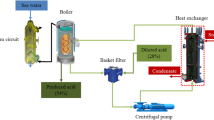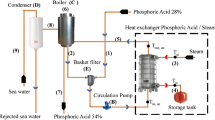Abstract
Fouling still remains one of the most difficult problems for the use of heat exchangers. A methodological process of advanced analysis of experimental data on heat exchangers fouling allowing building predictive models is necessary to determine the fouling degree. Here, three different methods were used to predict the fouling resistance from some easily measurable variables of the system which are: Kern and Seaton, Partial Least Squares (PLS) and Artificial Neural Networks (ANN). Indeed, the fouling resistance was estimated according to the inlet and outlet temperature of the cold fluid, the temperature of the hot fluid, the density and the volume flow rate of the cold fluid and time for three types of heat exchangers, i.e. tubular stainless-steel and graphite blocks (Supplier (A) and Supplier (B)).The best modeling was determined by maximizing certain statistical accuracy indices. Results show that modeling by the use of Artificial Neural Networks is very performing compared with modeling by Partial Least Squares regression and Kern and Seaton. One of the key features of ANN model is their small levels of error in comparison with other models.




















Similar content being viewed by others
Abbreviations
- AARD:
-
Absolute average relative deviation
- MSE:
-
Mean square error
- RMSE:
-
Root mean square error
- R2 :
-
Determination coefficient
- r2 :
-
Correlation coefficient
- C1 :
-
Coefficient in Eq. (15), Pa−1.s−1
- Cb :
-
Bulk concentration of particles, kg.m−3
- Cp:
-
Specific heat capacity, J.Kg−1.K−1
- Cw :
-
Concentration of particles at the wall, kg.m−3
- F:
-
Correction Factor (=1 for a steam condenser)
- g:
-
Gravity acceleration (=9.81 m.s−2)
- HMT:
-
Total manometric head, m
- kp :
-
Mass transfer coefficient, m.s−1
- mp :
-
Mass of deposited particles per surface area, kg.m−2
- ṁ:
-
Mass flow rate, kg.s−1
- N:
-
Observation number
- P:
-
Pressure, bar
- Q:
-
Thermal power,W
- Rf:
-
Fouling resistance, m2.K.W−1
- A:
-
Area, m2
- T:
-
Temperature, K
- t:
-
Time, h
- U:
-
Global exchange coefficient, W.m−2.K−1
- \( \dot{v} \) :
-
Volume flow rate, m3.h−1
- ρ :
-
Density, kg.m−3
- Φd :
-
Particle deposition rate, kg.m−2.s−1
- Φr :
-
Particle removal rate, kg.m−2.s−1
- τ :
-
Shear stress, Pa
- ϴ :
-
Time required to reach 63.2% of Rf*, h
- Δ:
-
Difference of greatness between two points
- ac:
-
Acid
- b:
-
Bulk
- cir:
-
Circulation
- d:
-
Deposition
- dis:
-
Discharge
- exp:
-
Experimental
- in:
-
Input
- ml:
-
Logarithmic mean
- 0:
-
clean
- out:
-
Output
- p:
-
Particle
- r:
-
Removal
- st:
-
Steam
- suc:
-
Suction
- w:
-
Wall
- *:
-
Asymptotic value
References
Demasles H, Mercier P, Tochon P, Thonon B (2007) Guide de l’encrassement des échangeurs de chaleur. Editions GRETh. France
Ogbonnaya SK, Ajayi OO (2017) Fouling phenomenon and its effect on heat exchanger: a review. Frontiers in heat and mass transfer 9:1–12
Jradi R, Fguiri A, Marvillet C, Jeday MR (2019) Tubular heat exchanger fouling in phosphoric acid concentration process. Inverse Heat Conduction and Heat Exchangers. Intechopen edition; 1–16. https://www.intechopen.com/online-first/tubular-heat-exchanger-fouling-in-phosphoric-acid-concentration-process
Muller-Steinhagen H, Reza Malayeri MR, Watkinson AP (2015) 10th International Conference on Heat Exchanger Fouling and Cleaning—2013 Budapest, Hungary. Heat transfer engineering 36:621–622
Ansari Md IA, Sahoo PK, Datta AK (2012) Milk fouling simulation in a triple tube heat exchanger. Journal of Agricultural Engineering 49:1–11
Muller-Steinhagen H (2011) Heat transfer fouling: 50 years after the Kern and Seaton model. Heat Transfer Engineering 32:1–13
Wang Y, Yuan Z, Liang Y, Xie Y, Chen X, Li X (2015) A review of experimental measurement and prediction models of crude oil fouling rate in crude refinery preheat trains. Asia Pac J Chem Eng 10:607–625
Mousavian S, Malayeri MR, Fahiminia F (2020) Mathematical modeling of initial fouling rate of calcium sulphate dehydrate based on nucleation rate. Heat and Mass Transfer. https://doi.org/10.1007/s00231-020-02847-4
Ishiyama EM, Pugh SJ, Wilson DI (2019) Incorporating deposit ageing into visualization of crude oil preheat train fouling. Process integration and optimization for sustainability. https://doi.org/10.1007/s41660-019-00104-8
Diaz-Bejarano E, Coletti F, Macchietto S (2019) Modeling and prediction of shell-side fouling in shell and tube heat exchangers. Heat Transfer Engineering 40:845–861. https://doi.org/10.1080/01457632.2018.1446814
Polley GT, Wilson DI, Yeap LB, Pugh SJ (2002) Use of crude oil threshold data in heat exchanger design. Appl Therm Eng 22:763–776
Rodriguez C, Smith R (2007) Optimization of operating conditions for mitigating fouling in heat exchanger networks. Chem Eng Res Des 85:839–851
Abiodun OI, Jantan A, Omolara AE, Dada KV, Mohamed NA, Arshad H (2018) State of the art in artificialneural networkapplications: a survey. Heliyon 4:1–41
Davoudi E, Vaferi B (2018) Applying artificial neural networks for systematic estimation of degree of fouling in heat exchangers. Chem Eng Res Des 130:138–153
Moya-Rico JD, Molina AE, Belmonte JF, Corcoles Tendero JI (2019) Almendros-Ibanez. Characterization of a triple concentric-tube heat exchanger with corrugated tubes using artificial neural Netwoek. Appl Therm Eng 147:1036–1046
Biyanto TR (2016) Fouling resistance prediction using artificial neural network non linear auto-regressive with exogenous input model based on operating conditions and fluid properties correlations. In: AIP Conference Proceedings, p. 1737
Schrodter K, Bettermann G, Staffel T, Klein T, Hofmann T (2000) Phosphoric acid and phosphates. Ullmann’s Encyclopedia of Industrial Chemistry. Wiley-VCH Verlag GmbH & Co edition
Weber C, Tremeac B, Marvillet C, Castelain C (2016) Analysis of different fouling predictive models in a heat exchanger from experimental data. In:Proc ECOS conf efficiency-cost-optimization-simulation and environmental impact of energy systems. Slovenia: Portoroz
Jradi R, Fguiri A, Marvillet C, Jeday MR (2019) Experimental analysis of heat transfer coefficients in phosphoric acid concentration process. Journal of Statistical Mechanics Theory and Experiment 2019:1–15. https://doi.org/10.1088/1742-5468/ab2531
Gholami E, Vaferi B, Ariana MA (2018) Prediction of viscosity of several alumina-based nanofluids using various artificial intelligence paradigms comparison with experimental data and empirical correlations. Powder Technol 323:495–506
Weber C (2018) Développement de méthodes d’analyse avancées de données expérimentales sur les phénomènes d’encrassement d’échangeurs thermiques en conditions réelles de fonctionnement. Université de Nantes, France
Peyghambarzadeh SM, Vatani A, Jamialahmadi M (2012) Experimental study of micro-particle fouling under forced convective heat transfer. Braz J Chem Eng 29:713–724
Ilaboya IR, Igbinedion OE (2019) Performance of multiple linear regression (MLP) and artificial neural network (ANN) for the prediction of monthly maximum rainfall in Benin City, Nigeria. International Journal of Engineering Science and Application 3:21–37
Al-Haj IH (2012) Fouling in heat exchangers. MATLAB – a fundamental tool for scientific computing and engineering applications. Intechopen edition 3:57–96
Davoudi E, Vaferi B (2017) Applying artificial neural networks for systematic estimation of degree of fouling in heat exchangers. Chem Eng Res Des 130:138–153
Awad MM (2012) Impact of flow velocity on surface particulate fouling - theoretical approach. Journal of American Science 8:442–449
Trzcinski P, Markowski M (2018) Diagnosis of the fouling effects in a Shell and tube heat exchanger using artificial neural network. Chem Eng Trans 70:355–360
Gautam R.K, Nirmal K.S, Parmar N, Vyas BG (2017) Effect of fouling on thermal and hydraulic parameter of Shell and tube heat exchanger, student conference 2017|Czech Technical University in Prague
Bayat M, Aminian J, Bazmi M, Shahhosseini S, Sharifi K (2012) CFD modeling of fouling in crude oil pre-heaters. Energy Convers Manag 64:344–350
Gurney K (2014) An introduction to neural networks. Taylor & Francis e-library, New York
Zhang Z, Wu Z, Rincon D, Christofides PD (2019) Real time optimization and control of nonlinear processes using machine learning. Mathematics 7:1–25
Rafiq M, Bugmann G, Easterbrook D (2001) Neural network design for engineering applications. Comput Struct 79:1541–1552
Basheer IA, Hajmeer M (2000) Artificial neural networks: fundamentals, computing, design, and application. J Microbiol Methods 43:3–31
Author information
Authors and Affiliations
Corresponding author
Additional information
Publisher’s note
Springer Nature remains neutral with regard to jurisdictional claims in published maps and institutional affiliations.
Rights and permissions
About this article
Cite this article
Jradi, R., Marvillet, C. & Jeday, M.R. Modeling and comparative study of heat exchangers fouling in phosphoric acid concentration plant using experimental data. Heat Mass Transfer 56, 2653–2666 (2020). https://doi.org/10.1007/s00231-020-02888-9
Received:
Accepted:
Published:
Issue Date:
DOI: https://doi.org/10.1007/s00231-020-02888-9




